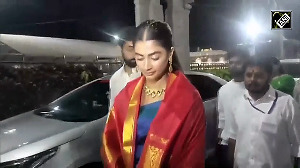Denying his role in the 26/11 attacks at the Chhatrapati Shivaji Railway Terminus, Pakistani terrorist Ajmal Kasab on Friday told the Bombay high court that police had cooked up a story to falsely implicate him in the crime.
Picking up holes in the prosecution's case and pointing out contradictions in the accounts of witnesses, defence lawyers Amin Solkar, Farhana Shah and Santosh Deshpande argued that Kasab was not present at CST when the incident happened.
"We do not deny the incident, we also do not dispute that two terrorists had fired at people... all that we say is that Kasab was not at CST at the relevant time," they told justices Ranjana Desai and R V More who are hearing arguments on confirmation of death sentence awarded to Kasab.
Kasab did not appear on the screen put up in the court for the video conference link to enable him hear the proceedings.
Solkar urged the judges to visit the terror spots personally to get a first hand impression of the topography in order to appreciate the evidence adduced by the prosecution against Kasab.
The judges said they were inclined to visit the spots and would fix up a day next week for this purpose. A decision on this matter would be taken soon, the bench said.
Earlier, senior sessions judge M L Tahaliyani, who had awarded death sentence to Kasab, had also visited the terror spots before the trial.
Solkar pointed out contradictions in the testimony of witnesses and said police constable Bharat Bhosale, who was injured in the shoot-out at CST, had disclosed that a hand grenade was thrown by terrorists first and then after 10 minutes they fired at people.
However, other witnesses were silent on this aspect, Solkar argued. Only one witness had said that there was an explosion at CST before the terrorists fired.
Other witnesses have said they heard two explosions and not one, Kasab's lawyer said. Solkar argued that constable Bhosale said he had seen Kasab reloading his rifle at CST but did not say anything to identify him.
He also did not describe Kasab in his statement to police although he identified Kasab in the court as the gunman who had fired at people.
"I had forgot to describe Kasab in statement to police," Bhosale had told the court. Moreover, Bhonsale was not shown Kasab's weapon in the trial court, Solkar submitted.
"This witness cannot be called reliable. His testimony should not be believed because he was not present at CST and was introduced by police to implicate Kasab," he argued.
The defence lawyer also disputed the presence of constable Jillu Jadhav who claimed to have confronted Kasab at CST by throwing a chair at him as his rifle got jammed and failed to fire bullets.
Solkar said Jadhav had told police as well as the court that he had hid himself behind a pillar to protect himself from the bullets fired by Kasab.
In such a situation, how could he see Kasab, more particularly when he was behind a pillar, he asked. Most of the witnesses have given a general description of Kasab as 'butka' (a person of short height) and his partner Abu Ismael as 'lambu' (a tall person). Such identification was not relevant and should be discarded, Solkar argued.
Also, the witnesses have said that they had seen Kasab and his accomplice from a distance of 25-30 feet. From such a distance, their faces cannot be seen clearly and hence it is difficult to believe that they had seen Kasab, the lawyer said.
The CCTV footages are also not visible and do not show the faces of Kasab and slain terrorist Abu Ismael clearly, the lawyer pointed out. Arguments were inconclusive and would continue tomorrow.
23-year-old Kasab, who is now confined to Arthur Road Central Jail, was awarded death sentence on May 6 by a trial court for his role in killing 166 people in the terror attacks plotted by Lashkar-e-Tayiba in Pakistan.
The sentence has come up for confirmation before the high court which would also hear the appeal filed by Kasab against his conviction as well as appeal filed by the state government against the acquittal of co-accused Faheem Ansari and Sabauddin Ahmed on account of "doubtful evidence".






 © 2025
© 2025